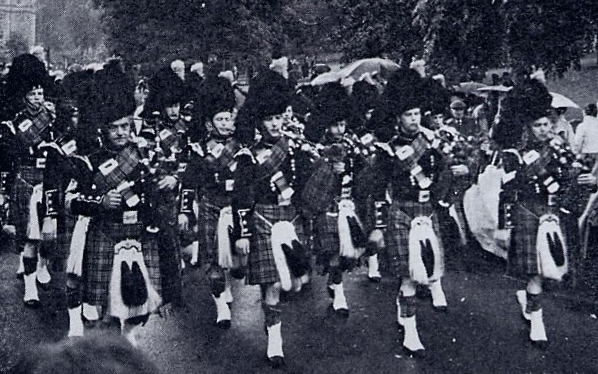
Pipe bands seem to have settled on a ‘no more than 25 pipers’ rule in the past couple of seasons. Before that we had showmen P/Ms turning out with nearer 30. Now they realise the difficulties this means for unison and control.

As I say, when you see the depleted ranks of a struggling band followed by the numerical power of a Shotts or a SLoT you can’t help but be impressed. But apart from this visual impact, there is no real advantage in having these juggernaut bands. Huge numbers of pipers make it all the more difficult to play with the required unison. Precision in technique suffers; it becomes woolly on the ear. The pipe major can lose control at breaks and in tempo change. Setting up and tuning becomes a lengthier undertaking.
I would be in favour of a cap of 20 pipers for all bands. Five ranks of four is plenty for any pipe major to be going on with and there are considerable benefits for the movement overall. Pipers on the periphery of a competing pool, unsure of getting a game at major championship, will lose interest and drift off to other organisations. It could lead to the formation of new bands or a boost for those at the bottom end of Grade 1, bands hungry for an influx of experienced, top-end, talent. Short on numbers and prospect of success, theirs is a sorry pursuit. Such a limit would help even things up and reduce the divide between top, middle and bottom.

If not a cap, then a Premier Grade for the top eight bands is imperative. I have written before about how this new grade would work: no more than four prizes and two going down each year and two coming up from the reduced Grade 1. The whole pipe band competing structure would be invigorated from the top down and I believe the bands would support it. It must be very dispiriting at the bottom end of Grade 1 to know that each competing day you have no chance of a prize – and when the young talent you have nurtured over many years is lost to the already burgeoning ranks of the big boys.
















I remember our near disbelief when The Clan MacFarlane Pipe Band of St.Catharines Ontario entered the ballroom of the Constellation Hotel in Toronto at the P.P.B.S.O’s Highland Ball back in 1979, with a whopping 18 players in their pipe section! To those of us in attendance that night, it seemed that the single file of pipers marching through the entrance onto the dance floor would never end! I doubt if any of us (perhaps excepting Bill Livingstone) in those days could ever have imagined fielding a band any larger than that. That was certainly pushing the envelope for the ’70’s.
I agree with limiting the number of pipers for competing bands. I remember when 16 was a HUGE number to march into the circle.
The top bands today sound great, but I bet they’d feel less stressed dealing with a finite number.
I do agree with a cap on pipers and drummers in the top 2 grades, I believe bands should have to register their competing players by march for the impending outdoor competition season with a cap of say 23 pipers, but only 20 pipers allowed on the field.
Same with drummers max say 10 sides with 8 competing players.
There should be a transfer window from say October -December
This would allow interested players to approach and audition for new bands.
Pipe majors would know exactly who they have to work with and a settled group.
Any players who didn’t make the 23 would be notified and have time to find another band.
Available players could perhaps be on a public list on the Rspba website and prospective bands could contact them, if you don’t want to be contacted or are not keen on competing that year you opt out?
As for a premiere grade I personally feel this is not the way to go. The bands you have mentioned in your article, I’m sure would agree, they have fought hard to achieve grade1 status and just to play in the same circle as other grade1 bands would be amazing. Yes they may not break a top 6 finish but they are where they want to be, they have achieved grade1 status.
On a final note I also disagree with your thoughts on sizes of bands and wether a smaller corp can compete against a large.
Listening to the commentary of the worlds dvd’s for many of the previous years it appears that others agree with me also.
A smaller band can not achieve the same depth, can not play at the same pitch due to this and it is of huge detriment to them when it comes to placing a.
I have played in numerous small corp bands and it has been detailed within critique sheets that the lack of numbers held us back.
Great read all the same
While I agree that there would be advantages for smaller/lower grade bands in capping numbers Rab, I can’t see any advantage in creating a premier grade.
The top bands of the day will always remain that, no matter what the grade is called. Players naturally want to play with the best bands in the world and if their ability wont allow that, then competing against them will be the best they can hope for.
I do not know how many grade one bands there are worldwide at present, probably between 20 and 30, with the vast majority no great threat to the likes of Inverary, FM or the O’Tooles. There were only 7 bands made it into the prize list at the 5 majors last season with the top 5 placed every time and Spirit of Scotland and Fife Police fighting it out for the lower places. I don’t think another creating another grade will bring Buchan or the PSNI any closer to these bands.
In fact I think by creating a premier grade it would have the effect of making the these elite bands a far more attractive proposition (if that’s possible) than grade 1 to up and coming players and help to create an even bigger gulf between them.
I’m not too convinced about the “2 up, 2 down” idea either, my understanding of the grading system is that bands are not upgraded unless the music board believe they are good enough for the grade, which is why there is currently no automatic re grading.
On the practical side, how much longer in the march past at the World Championships likely to take with yet another grade. Now run over 2 days, but the winning band playing off after 8 at night when it’s almost dark.